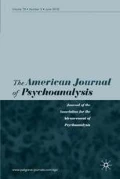Most people are other people. Their thoughts are someone else’s opinions, their lives a mimicry, their passions a quotation.
Oscar Wilde
Abstract
This paper investigates the concept of “total situation” which, even though introduced into psychoanalytic thinking via sister disciplines, such as sociology, the neurosciences, etc., has gradually acquired a relatively prominent position in current therapeutic practice. It is used as a metaphor for the envelopment of the unfolding transferential and related events in the analytic process. Irrespective of whether one focuses on the individual analytic condition or the group-analytic one, contemporary psychoanalytic perspectives include both the bi-personal unconscious interactions and the various levels of the total situation in their conceptualizations of the nature of the process. Such a complex approach in conceptualization can only be achieved through the so-called binocular vision of the analyst.
Similar content being viewed by others
References
Adorno, T. (1951). Minima Moralia: Reflections from a damaged life (p. 1981). London: Verso Books.
Agazarian, Y. M. (1989). Group-as-a-whole: Systems theory and practice. Group, 13, 131–154.
Anzieu, D. (1966). Étude psychanalytique des groupes réels. Les Temps Modernes, 242, 56–73.
Aulagnier, P. (2001). The violence of interpretation: From pictogram to statement. London: Brunner-Routledge.
Baranger, M., & Baranger, W. (2008). The analytic situation as a dynamic field. International Journal of Psychoanalysis, 89, 795–826.
Baranger, M., Baranger, W., & Mom, J. (1983). Process and non-process in analytic work. International Journal of Psychoanalysis, 64, 1–15.
Bion, W. R. (1961). Experiences in groups and other papers. London: Tavistock.
Bion, W. (1962). Learning from experience. London: Tavistock.
Bion, W. (1965). Transformations. London: Heinemann.
Bion, W. (1970). Attention and interpretation. London: Tavistock.
Bion, W. (1992). Cogitations. London: Karnac Books.
Bleger, J. (1964). El grupo como institución y el grupo en las instituciones. In Jose Bleger (ed.) Temas de psicologia: Entrevistas y grupos. (pp. 101–123) Buenos Aires: Nueva Visión. 1971.
Carnochan, P. (2011). Jealousy and the capacity to imagine: commentary on paper by Stephanie Lewin. Psychoanalytic Dialogues, 21, 580–588.
Cavell, M. (1991). The subject of mind. International Journal of Psychoanalysis, 72, 141–154.
Charles, M. (2003). Mirroring from the perspective of the theories of Matte-Blanco. Psychoanalytic Review, 90, 791–809.
Charles, M. (2016). Race and recognition: The time of our singing. American Journal of Psychoanalysis, 76, 140–160.
Civitarese, G. (2011). Exploring core concepts: Sexuality, dreams and the unconscious. International Journal of Psychoanalysis, 92, 277–280.
Davies, J. D. (1955). Phrenology: Fad and science: A 19th-century American crusade. New Haven: Yale University Press.
Eigen, M. (1981). The area of faith in Winnicott, Lacan and Bion. International Journal of Psychoanalysis, 62, 413–433.
Eisold, K. (1985). Recovering Bion’s contributions to group analysis. American Journal of Psychoanalysis, 45, 327–340.
Elias, N. S. (1939). Civilizing process. Oxford: Blackwell. 1978.
Foulkes, S. H. (1948). Introduction to group analytic psychotherapy. London: Karnac. 1983.
Foulkes, S. (1974). My philosophy in psychotherapy. Journal of Contemporary Psychotherapy, 6, 109–114.
Freud, S. (1900). The interpretation of dreams (Vols. 4–5, pp. 1–626)., Standard Edition London: Hogarth.
Freud, S. (1914). On narcissism: An introduction (Vol. 14, pp. 67–103)., Standard Edition London: Hogarth.
Freud, S. (1919). Lines in advance of psychoanalytic therapy (Vol. 17, pp. 157–168)., Standard Edition London: Hogarth.
Freud, S. (1921). Group psychology and the analysis of the Ego (Vol. 18, pp. 65–143)., Standard Edition London: Hogarth.
Gadamer, H-G. (1976). Philosophical hermeneutics. D. Linge (Ed. & Trans.) Berkeley: University of California Press.
Goldstein, K. (1934). The organism: A holistic approach to biology derived from pathological data in man (p. 1939). New York: American Book Co.
Grínberg, L., Sor, D., & De Blanchedi, E. T. (1974). Bion’s concept of psychosis. Contemporary Psychoanalysis, 10, 157–171.
Grotstein, J. S. (2004). “The light militia of the lower sky”: The deeper nature of dreaming and phantasying. Psychoanalytic Dialogues, 14, 99–118.
Joseph, B. (1985). Transference: The total situation. International Journal of Psychoanalysis, 66, 447–454.
Kaës, R. (1993). Le groupe et le sujet du groupe. Eléments pour une théorie psychanalytique des groupes. Paris: Dunod.
Kelman, H. (1944). A new approach to dream interpretation. American Journal of Psychoanalysis, 4, 89–107.
Kelman, H. (1956). Goals in therapy: a Roundtable discussion. American Journal of Psychoanalysis, 16, 3–4.
Klein, M. (1940). Mourning and its relation to manic-depressive states. International Journal of Psychoanalysis, 21, 125–153.
Klein, M. (1952). The origins of transference. International Journal of Psychoanalysis, 33, 433–438.
Loewald, H. (1970). Psychoanalytic theory and the psychoanalytic process. Psychoanalytic Study of the Child, 25, 45–68.
Meltzer, D. (1978). The Kleinian development. London: Karnac Books.
Milner, M. (1945). Some aspects of phantasy in relation to general psychology. International Journal of Psychoanalysis, 26, 143–152.
Ogden, T. (2003). What is true and whose idea was it? International Journal of Psychoanalysis, 84, 593–606.
Pontalis, J.-B. (1963). Le petit groupe comme objet. Les Temps Modernes, 211, 1057–1069.
Racker, H. (1957). The meanings and uses of countertransference. Psychoanalytic Quarterly, 26, 303–357.
Sandler, J. (1960). On the concept of superego. Psychoanalytic Study of the Child, 15, 128–162.
Stace, W. T. (1955). The philosophy of Hegel. New York: Dover Publications.
Whitaker, C. (1955). The doctor-patient relationship in therapy: A roundtable discussion. American Journal of Psychoanalysis, 15, 19–21.
Whitehead, C. (2001). Social mirrors and shared experiential worlds. Journal of Consciousness Studies, 8, 3–36.
Winnicott, D. W. (1958). Through paediatrics to psychoanalysis. London: Hogarth. 1975.
Winnicott, D. W. (1986). Holding and interpretation: Fragment of an analysis. London: Hogarth.
Author information
Authors and Affiliations
Additional information
Address Correspondence to Dr. Christo Joannidis, Eth Antistaseos 65, Halandri 15231, Athens, Greece.
Rights and permissions
About this article
Cite this article
Joannidis, C. Binocular Vision in the Total Situation. Am J Psychoanal 78, 74–88 (2018). https://doi.org/10.1057/s11231-017-9124-3
Published:
Issue Date:
DOI: https://doi.org/10.1057/s11231-017-9124-3




